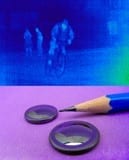
If visibility is poor, thermal cameras can warn drivers of people or animals on the road.
Yet such devices have been very expensive – until now. An important step has been taken to manufacture them more cheaply. A new process will make the infrared lenses – a component of such cameras – up to 70 percent cheaper.
Rain pelts down on the roof of the car; it is difficult to make out anything in the pitch dark. Suddenly, a deer runs out of the forest and onto the road, but the driver cannot respond in time. When it comes to such dangerous situations, micro-bolometers constitute one way of “extending” the human eye and defusing such dangerous situations. They detect infrared rays – in other words, the heat emitted by a living creature – and in case of danger, warn the driver through an acoustic signal or a warning light. At about 2,000 euros, these devices are still quite expensive and are only being used in luxury-class vehicles.
Production costs drop by over 70 percent
Part for part, these devices should be getting more affordable. Researchers at the Fraunhofer Institute for Mechanics of Materials IWM in Freiburg are working on the infrared lenses that are in the cameras. “We have developed a production process for lenses that enables us to lower the costs of these components by more than 70 percent. Thus the prize for the micro-bolometer could be reduced,” says Dr. Helen Müller, scientist at IWM. Normally, the lenses are made out of crystalline materials like germanium, zinc selenide or zinc sulfide. The problem is that these materials are very expensive and can only be processed mechanically – it takes grinding, polishing or diamond turning to shape them into the correctly. Obviously this involves high processing costs. “Instead of crystalline materials, we use the amorphous chalcogenide glass. Its softening temperature – that is, the temperature at which it can be formed – is low. Therefore, we can form it using non-isothermic hot stamping,” says Müller.
This process is similar to making waffles on a waffle iron. The researchers place the chalcogenide glass between two pressing tools which determine the form of the required lenses. Then, it is heated and formed between both pressing tools – the “waffle iron” is clamped together. After a few minutes, the glass is cooled again to below the softening temperature and removed. And thus, the lens is already perfect. In contrast to conventionally processed optics, it no longer has to be further refined. The lenses manufactured this way exhibit the same excellent optical imaging quality as those that are polished. To ensure that no glass remains attached to the tools, their surface is coated with anti-adhesive, non-stick coatings, similar to the Teflon coating on a waffle iron. The scientists now want to further refine the process towards cost-effective mass production.
via Fraunhofer
The Latest Streaming News: infrared lenses updated minute-by-minute
Bookmark this page and come back often
Latest NEWS
Latest VIDEO







